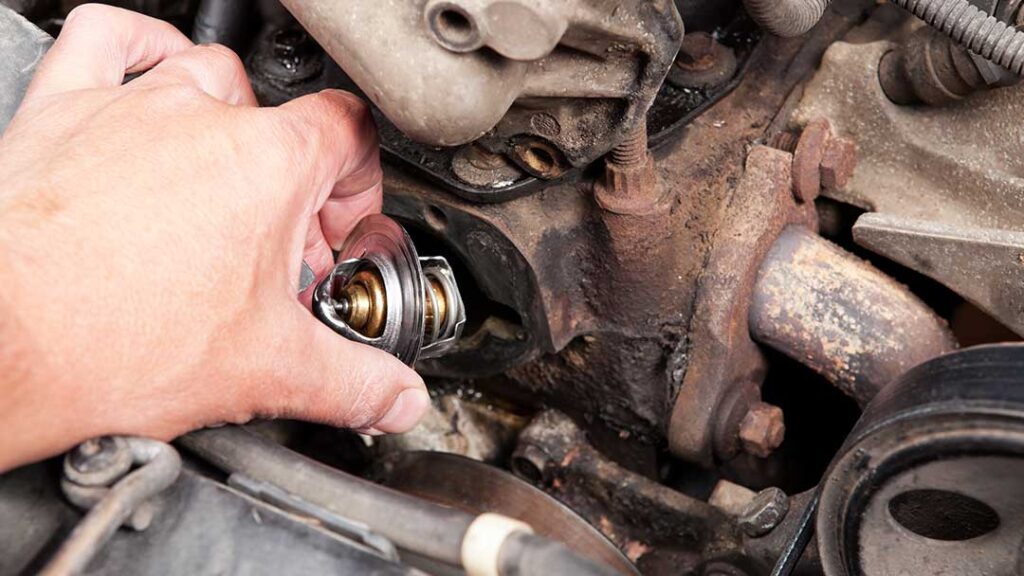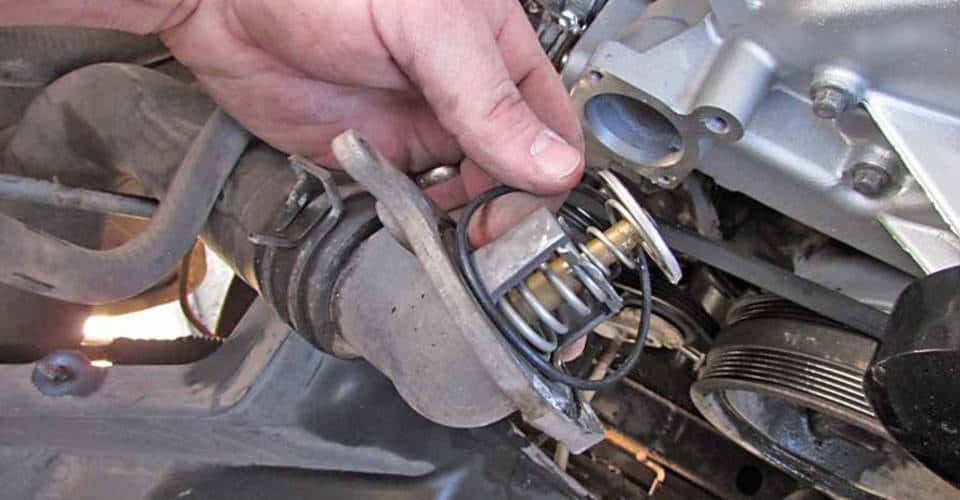A thermostat is an important component of a car’s cooling system, as it regulates the flow of coolant through the engine to maintain the optimal operating temperature. If the thermostat becomes stuck, it can cause the engine to run too hot or too cold, which can lead to performance issues and even engine damage. In this article, we’ll provide a step-by-step guide on how to unstick a thermostat in a car.
We’ll also discuss some of the common causes of a stuck thermostat and how to prevent it from happening again in the future. By following these steps, you can get your car running smoothly and avoid costly repairs.
What Does A Car Thermostat Do?
A car thermostat is a valve that controls the flow of coolant in the engine’s cooling system. It is typically located in the engine block or cylinder head, and is connected to the radiator by a series of hoses.
The thermostat is designed to open and close based on the temperature of the coolant. When the engine is cold, the thermostat stays closed, preventing the coolant from flowing through the radiator.
As the engine heats up, the thermostat opens, allowing the coolant to flow through the radiator and dissipate heat. This helps to regulate the engine temperature and prevent overheating.
Step-by-Step Guide To Unstick A Thermostat In A Car

Locate the thermostat
The thermostat is typically located in the engine block or cylinder head, and is connected to the radiator by a series of hoses.
Drain the cooling system
Before attempting to remove the thermostat, it is important to drain the cooling system to prevent coolant from spilling out. To do this, locate the drain valve at the bottom of the radiator and open it to allow the coolant to drain out.
Disconnect the hoses
Once the cooling system has been drained, you can proceed to disconnect the hoses that connect the thermostat to the radiator. Be sure to use a wrench to loosen the hose clamps and carefully remove the hoses.
Remove the thermostat
The thermostat is typically held in place by bolts or a mounting bracket. Use a wrench or socket set to remove the bolts and carefully remove the thermostat from the engine.
Inspect the thermostat
Once the thermostat has been removed, inspect it for any visible signs of damage or wear. If the thermostat appears to be damaged, it will need to be replaced. If it appears to be in good condition, it may be possible to clean it and reinstall it.
Clean the thermostat
If the thermostat appears to be in good condition, you can try cleaning it to see if that resolves the issue. To clean the thermostat, soak it in a mixture of water and vinegar for a few hours, then scrub it with a small brush to remove any dirt or debris. Rinse it off with water and dry it thoroughly before re-installing it.
Re-install the thermostat

Once the thermostat has been cleaned or replaced, it’s time to re-install it. Start by connecting the hoses and tightening the hose clamps, then re-install the thermostat in the engine block or cylinder head using the bolts or mounting bracket.
Refill the cooling system
Once the thermostat has been re-installed, you can refill the cooling system with new coolant. Be sure to follow the manufacturer’s recommendations for the type of coolant to use and the correct mixture ratio.
Test the thermostat
After the cooling system has been refilled, start the engine and allow it to warm up. Observe the thermostat to ensure that it is opening and closing correctly. If it appears to be functioning properly, you can consider the job complete. If the thermostat is still stuck, it may be necessary to seek further assistance from a mechanic.
By following these steps, you can unstick a thermostat in a car and get your engine running smoothly again. If you are not comfortable attempting this repair on your own, it is always best to seek the assistance of a qualified mechanic.
What Causes a Stick Thermostat
There are several possible causes of a stuck thermostat in a car:
Debris or dirt: If debris or dirt accumulates in the thermostat housing, it can cause the thermostat to become stuck in the closed or open position.
Wear and tear: Over time, the thermostat may become worn out or damaged, which can cause it to stick.
Coolant leak: A coolant leak can cause the thermostat to become stuck in the open position, as there is not enough coolant in the system to create sufficient pressure to open the thermostat.
Mechanical issues: In some cases, a stuck thermostat can be caused by mechanical issues, such as a faulty valve or a damaged spring. These issues may be the result of wear and tear or may be caused by an accident or collision.
Incorrect installation: If the thermostat is installed incorrectly, it may not function properly and could become stuck. This can be caused by a variety of factors, including improper installation techniques or the use of incorrect parts.
Failed gasket or seal: The thermostat is typically sealed in place with a gasket or seal. If this gasket or seal fails, it can cause the thermostat to become stuck.
How to Tell If Your Thermostat Is Stuck
There are several signs that may indicate that the thermostat in your car is stuck:
- Overheating: If the thermostat is stuck in the closed position, it can cause the engine to overheat. This may be indicated by the temperature gauge on the dashboard rising into the red zone or by steam coming from under the hood.
- Poor engine performance: If the thermostat is stuck in the open position, it can prevent the engine from reaching its optimal operating temperature. This can lead to reduced engine performance and fuel efficiency.
- Coolant level fluctuation: If the thermostat is stuck in the open position, it can cause the coolant level to drop significantly. Conversely, if the thermostat is stuck in the closed position, it can cause the coolant level to rise.
- Coolant leak: If the thermostat is stuck in the open position, it can cause a coolant leak. This may be indicated by a puddle of coolant under the car or by a low coolant level in the radiator.
If you notice any of these signs, it is important to address the issue as soon as possible to prevent further damage to the engine. If you are not sure whether the thermostat is stuck, it is always best to seek the assistance of a qualified mechanic.
How do I prevent my thermostat from becoming stuck in the future?
To prevent your thermostat from becoming stuck in the future, you can take the following steps:
- Regularly maintain your car’s cooling system. This includes flushing the system, replacing coolant, and checking hoses and belts for wear.
- Change the thermostat as recommended by the manufacturer. Consult your car’s owner’s manual for the recommended replacement interval.
- Avoid driving in extreme temperatures. If possible, try to avoid driving in extremely hot or cold weather, as these conditions can put added strain on the thermostat.
- Properly winterize your car. If you live in a cold climate, make sure to properly winterize your car by adding antifreeze to the cooling system and checking for leaks in the hoses.
- Avoid using cheap or low-quality thermostats. Invest in a high-quality thermostat to ensure it lasts longer and performs better.
FAQS
Q: Is it safe to drive with a stuck thermostat?
A: It is not safe to drive with a stuck thermostat. A stuck thermostat can cause your car to overheat, which can cause serious damage to the engine. If you suspect a stuck thermostat, it is best to consult a mechanic and have the issue addressed as soon as possible
Q: Can a stuck thermostat damage my car?
A: A stuck thermostat can damage your car if it causes the engine to overheat. Overheating can cause serious damage to the engine, including warping and melting of engine components.
Q: Can a stuck thermostat cause my car to overheat?
A: Yes, a stuck thermostat can cause your car to overheat. If the thermostat is stuck in the closed position, it can prevent coolant from flowing through the engine, causing the engine to overheat.
Q: How do I know if my thermostat is stuck?
A: To determine if your thermostat is stuck, check the temperature gauge on the dashboard. If the gauge is consistently reading low or not moving, it could be a sign of a stuck thermostat. You can also check the engine temperature by touching the radiator hose. If it is cool to the touch, it could be a sign of a stuck thermostat. Additionally, listen for unusual engine noises and check for overheating.
Q: What are the risks of attempting to unstick a thermostat yourself?
A: There are several risks involved in attempting to unstick a thermostat yourself, including damaging the thermostat or causing harm to yourself. If you are not comfortable with the process, it is best to consult a mechanic for assistance.
CONCLUSION
Regularly checking and maintaining your car’s thermostat can help ensure that your vehicle runs smoothly and efficiently. By following the steps outlined in our blog, you can unstick a thermostat on your own and prevent future issues from occurring. However, if you are not comfortable with the process or do not have the necessary tools and knowledge, it is always best to consult a mechanic for assistance. Remember, investing in proper automobile maintenance is important to ensure the longevity and performance of your vehicle.
FOLLOW US
